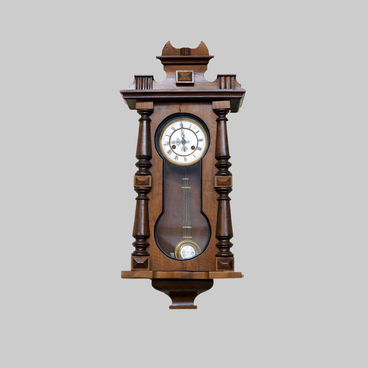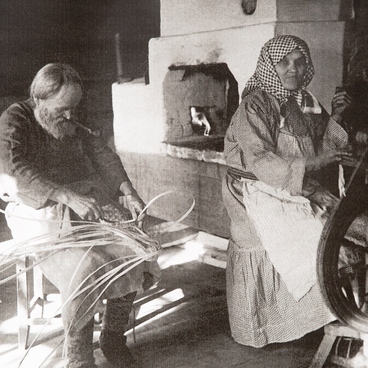The exhibition showcases a mechanical clock with a pendulum in a dark wooden case. The outer side of the clock case is decorated with turning and carving. It also features inlaid thin metal plates. The clock is designed in the classical style with a round white dial and Roman numerals. This wall clock features two weights shaped as elongated cones hanging on chains. The clock movement was driven with weights hanging on chains: the weights charged the chime and wound up the clock.
The clock belonged to the family of workers of the Izhevsk factory. For a long time, a wall clock and a samovar symbolized wealth and prosperity of a family. Clocks in the house were a sign of wealth of Izhevsk workers.
The first registered evidence of a clock in Russia dates back to 1404, when the Athos monk Lazar from Serbia installed a clock with chimes on a tower of the palace of the Grand Prince Vasily Dmitriyevich in Moscow. It is a known fact that the Kremlin’s Spasskaya and Troitskaya towers were equipped with tower clocks in the 16th–17th centuries. They were modified several times.
In the 18th century, reforms of Peter the Great created favourable conditions for successful development of the European clock-making business in Russia. The first wall clock appeared in Russia under Peter the Great. Soon, the Russian craftsmen mastered this trade as well. The empresses Catherine I, Yelizaveta Petrovna, and Catherine the Great received pendulum clocks and pocket watches made by the best craftsmen of the UK and France. Since many watchmakers lived in St. Petersburg and Moscow, the first Russian watch manufactories appeared in the late 18th century. A watch-making school opened in St. Petersurg in the first half of the 19th century. So the number of watchmakers increased.
Nevertheless, Russia still imported a large number of European watch models. High-quality and complicated mechanisms were appreciated in Russia, and the best European watchmakers still sent their products. A mechanico-optical and watchmaking school was opened in St. Petersburg in 1900. It was headed by the Professor Norbert Zavadsky, one of the founders of technical education in the precision instruments industry in Russia.
The clock belonged to the family of workers of the Izhevsk factory. For a long time, a wall clock and a samovar symbolized wealth and prosperity of a family. Clocks in the house were a sign of wealth of Izhevsk workers.
The first registered evidence of a clock in Russia dates back to 1404, when the Athos monk Lazar from Serbia installed a clock with chimes on a tower of the palace of the Grand Prince Vasily Dmitriyevich in Moscow. It is a known fact that the Kremlin’s Spasskaya and Troitskaya towers were equipped with tower clocks in the 16th–17th centuries. They were modified several times.
In the 18th century, reforms of Peter the Great created favourable conditions for successful development of the European clock-making business in Russia. The first wall clock appeared in Russia under Peter the Great. Soon, the Russian craftsmen mastered this trade as well. The empresses Catherine I, Yelizaveta Petrovna, and Catherine the Great received pendulum clocks and pocket watches made by the best craftsmen of the UK and France. Since many watchmakers lived in St. Petersburg and Moscow, the first Russian watch manufactories appeared in the late 18th century. A watch-making school opened in St. Petersurg in the first half of the 19th century. So the number of watchmakers increased.
Nevertheless, Russia still imported a large number of European watch models. High-quality and complicated mechanisms were appreciated in Russia, and the best European watchmakers still sent their products. A mechanico-optical and watchmaking school was opened in St. Petersburg in 1900. It was headed by the Professor Norbert Zavadsky, one of the founders of technical education in the precision instruments industry in Russia.



